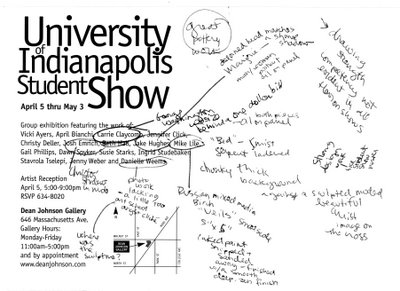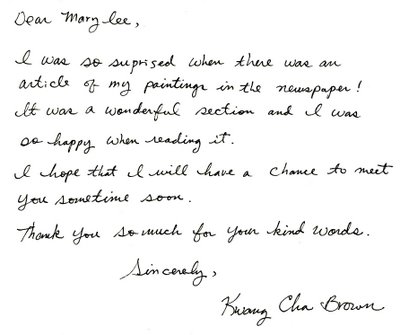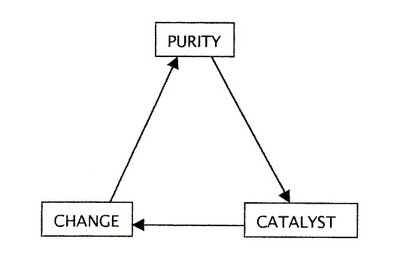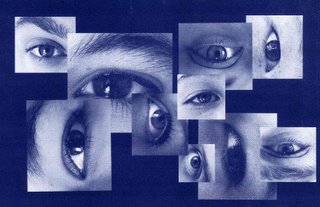An art critique as well as exhibition preview and overview archive spanning from 1999 to 2012 by Mary Lee Pappas, the art critic for the alternative weekly newspaper, NUVO, and visual arts columnist for the daily paper, The Indianapolis Star. Indianapolis, Indiana.
Ad
Wednesday, May 15, 2002
Oreho tehkhnee/beautiful art - Christos Koutouras - May 15 - 22, 2002
Wednesday, April 24, 2002
“Twilight in Arcadia: Tobacco Farming in Indiana” - Indiana Historical Society – April 24, 2002 – 3 1/2 stars
Ron Leonetti, Mavis Flora DeVoe, John Green John – The Photography Gallery at the Hyatt Regency – April 24, 2002 – 3 stars
Wednesday, April 17, 2002
“Colors of Indiana” John Domont – Domont Studio Gallery – April 17, 2002 – 4 stars
University of Indianapolis Student Show – Dean Johnson Gallery – April 17, 2002 – 3 1/2 stars

The scribbling on the postcard above are my notes for the critique below. That's how I write critiques - on whatever scrap piece of paper I have handy. I just usually need to write a key word to bring an image I viewed to life in my mind.
The gallery renews itself with refreshing new work by 16 students that smoothly knock most of the recycled, Herron-looking work at various Herron senior shows out of new art contention. Exceptions were the sculpture and photography, which were just a tad on the art school angst side. The show’s strengths are most evident in strong basic drawing competency and fluid graphic design as demonstrated in the student show poster. Josh Emrich offers technical and expressive maturity in his large-scale figurative painting while Carrie Claycomb's nearly life-size George Washington and Crucifixion paintings exhibit color and in-your-face composition confidence. A chunky, thick paint background frames a softly sculpted, molded image of Christ. Other paintings by Jake Hughes and Mike Lile serve as notable examples of real talent and visual refinement not always seen in local student shows. It is unfortunate that the opening reception had so few attendees when the work as this excellent. Through May 3, 2002; 317-634-8020, www.deanjohnson.com. -Mary Lee Pappas
Wednesday, April 10, 2002
“Symphony in Color, A Young People’s Art Contest” – Indianapolis Museum of Art – April 10, 2002 – 3 1/2 stars
“Learning to See: The Art of Art Education” – Herron Gallery - April 10, 2002 – 4 stars
Kwang Cha Brown - CCA Gallery – April 10, 2002 – 4 stars

Three pieces by this Herron painting BFA, Indiana State University MFA and Pont-Aven School of Art attendee are masterful impressionistic paintings rich with the lush, deep tones of caked oil paint one would expect to see on museum walls, particularly when juxtaposed against most CCA sterile standards. Brush strokes look intentionally inspired, as if she is painting history or painting from her past life. One landscape's amber yellow grassy foreground, with its specific speckled strokes, sinks into its green grassy background. Visual appearances of atmosphere and light are brilliantly interpreted. Through May 31, 2002; 317-255-9633. -Mary Lee Pappas

Wednesday, March 06, 2002
Art stalwarts closing - March 6 - 13, 2002
Art stalwarts closing
NUVO Newsweekly, March 6 - 13, 2002
Page 8
Wednesday, February 27, 2002
“White Light” Joy Jackson – Harrison Center for the Arts – Feb. 27, 2002 – 3 1/2 stars

No relation (or inspiration) to the Herron show of last September by the same name, its examination of white light is less precise and simplified into a metaphor for purity as a catalyst for change. Jackson, who teaches glass blowing at the Indianapolis Art Center, having received her MFA in the subject at Temple University in Philadelphia, presents 20 clear, milky and white glass vases sitting upon suspended wire and perfecting eye-level glass shelving cutting across one of the gallery's corners. Jackson, an installation artist of talent, transforms the gallery space into her unique environment moreso than any other paintings-perfectly-centered-on-the-wall exhibit in this space has even come close to with lighting and installation, tic tac mask sculptures and glassware. A 2,000-pound Morton salt block installation is ghostly unnatural with its electric blue-tinged white light emitting from the crevices of the manufactured salt bricks. Under ownership of Redeemer Presbyterian Church the Harrison Gallery is improved with this exhibit as its proof, Through April 7, 2002; 317-514-6787. – Mary Lee Pappas
“Enchanted Bloom” Andrea Eberbach and Riccardo Consciasecca – Hilbert Conservatory, White River Gardens – Feb. 27, 2002 – 3 stars
Wednesday, February 20, 2002
“A Hobby Handed Down” Elizabeth Young – College Ave. Library – Feb. 20, 2002 – 2 1/2 stars
Brian L. Phillips - Barnes & Noble – Feb. 20, 2002 – 2 1/2 stars
Wednesday, January 30, 2002
Cheryl Paswater – The Bungalow – Jan. 30, 2002 – 3 stars
“Behold” Sandy Day and Sara Vanderkleed – Hoosier Salon – Jan. 30, 2002 – 2 1/2 stars
Greg Brown's misfit masterpieces
NUVO Newsweekly, January 30 to February 6, 2002
Page 8
Mary Lee Pappas
An eccentric repository for orphaned kitsch paintings, Utrillo's Art Gallery, appropriately named for a so-so artist whose work was mass-marketed in the 1950s, falls someplace between a thrift shop and a gallery. “I collect art from the thrift store,“ Greg Brown, artist an owner of Utrill's Art, states. Provincial grandma art, religious kitsch, student stuff, paint by numbers and 1950s schlock reproduction popular prints are among the genres of original kitsch art paintings he emancipates from thrift shop shelves. Some are kept for his personal collection, others are sold.
“More people’s paintings are going to end up at thrift shops the museums,“ Brown says. “Thrift stores make art valuable,“ and affordable for anyone to own.
Brown has been conducting misfit masterpiece search and rescue missions since opening his first shop at 10th and Rural in December 1994. That venue became a successful free-form arts space for five years, before moving to the current location at 3318 E. 10th St., where the focus is kitsch recovery and frame sales. Original fine’s cell anywhere from $5 to $500 to a clientele Brown described as “a real wide variety.“ He adds that some people are embarrassed to admit they like this instinctive, thrift shop sort of art. Regular Utrillo customers “are right across the social spectrum. All shapes and sizes and colors and economic conditions – everybody. It’s neat that way.“ Brown’s collecting advice is, “start cheap and work your way up.“
Brown is supporting the local arts in a very fundamental way. He understands, validates and celebrates the simplicity and necessity of self expression. He knows and already practices with the Arts Council of Indianapolis is preaching in their new the Arts Can Help add campaign: “The arts play an integral role in the daily fabric of our lives… We work hard to support the creative and meaningful work of our arts and cultural organizations as well as our local talented artist.“ The difference is they see “critical activities for the arts community," as their website and TicketCentral in the ArtsGarden, stating, “Your assistance is needed to help us continue to create the best climate for the arts to thrive."
The anonymous, untrained and amateur artists whose salvaged work winds up at Utrillo's paint in a style affectionately dubbed “naïve." Brown defines naïve artist as those “who have a sense of art history and strive to paint in a European style,“ though they actually have no training, sense of depth, composition or color. Creating art is purely joy filled and experiential for them. “I like that kind of sweet art,“ Brown explains.
Some naïve art comes straight from artist to him without the second-hand retrieval effort. Jerome Neil, Jan Boyer and Harry Blomme are three such artist in Indianapolis who are represented at Utrillo's. “I try to promote stuff I love personally,“ Brown says. “Different artists have different needs for representation. I promote amateur art and naive art because I feel it’s important to validate."
Brown, who received formal art training at Indiana University in Bloomington, recently examined his fascination with naïve art by attempting to paint similarly styled figures. “One thing I was really bad at was figures. I thought, I’m gonna do something I don’t know how to do." Humbled, he gained valuable personal insight about how art should be approached. “That was the hardest thing.“ Brown says. “The simplicity embarrassed me. Why could I love it in somebody else and not love it for myself? That’s when I really started to examine my attitude toward art.“
Brown deduced the art he loved represented emotional, private and meditative qualities derived from the primary, free and flexible act of making art. Naïve art became for him, “people really trying really hard to do something they wanted to do." They are honest artistic efforts that liberate personal creativity, produce pride, create a sense of fulfillment and artistic accomplishment. Brown concluded that the sweeping demographic eureka, that anyone can paint, was precisely why he sells and collects this kind of work. “They do it for love and I think it comes through."
Brown adds, “Art is not for the elite anymore." The arts have to be for everyone now, as elitist dwindle and charitable anonymity seems passé. “It’s a breakdown of dominance,“ Brown says.
Paint by numbers kits, recently celebrated an annual exhibition at the Smithsonian, and once thought to be a violation of art by arts aficionados, testify to the power, need and desire for personal expression – even if simulated. Realistically themed kits introduced people to art, supplies, the process of creating, personal expression (albeit predetermined) and gave them works of art to hang in their homes. The paint by numbers paintings, which Brown collects, became a popular pastime in the 1950s when increased prosperity, consumerism and leisure time were on the rise. The art experience suddenly became easily accessible at an affordable price.
“People are starting to look toward art. The inherent experience of painting and being creative is a good common ground,“ Brown says. “The breakdown of the rules will disperse art into the general population. Some people will be offended and some people are gonna be thrilled. I see the universality of it, but I also insist on my own personal path." Brown knows the principle of joy that creating and observing art produces – and how that experience can be muddled or lost in the arts administration underbrush of grants, commissions or capital campaigns. Of his forsaken finds, he says, “They’re worth more than three dollars to me."
Jerome Neil
“This is my think tank,“ Jerome Neil said of his Wheeler art studio. Born and raised in Chicago, a lifelong Midwestern inhabitant, Neil has been humbly selling (his painting start at $65) and exhibiting his work here and there for four decades. The Wheeler has enabled him to pursue his newfound, full-time artist life. Paintings of airplanes, dinosaurs, trains, cowboys, landscapes, musicians, monorails, Dick Tracy, Roman soldiers and an R2-D2 portrait – “I’m on a Star Wars kick for the kids“ – are perched, displayed and stacked anywhere space allows.
“There’s no special topic. I paint what I want to,“ he says of his diverse imagery that stylistically hops, skips and jumps, from traditional tree filled landscapes to energy and people filled murals. “Figuring out what color you’re gonna to start with is hard, but they’re nope problem,“ he says of his even more different, yet proficiently composed, tribal and angular abstracts. Most of his can’t-pin-the-tail-down instinctive works are randomly named after song titles from his jazz record collection and fueled by his love of world history.
“That is it. That’s the main thing,“ he says of his passion for the past. A whole new series of Paris, London and Amsterdam Street scenes and architectural paintings, inspired by a recent tour of Europe with his children, have begun to creep across what little wall space is left. Could the painting of Notre Dame be named “April in Paris “or “Cool Boppin'"?
“It was wild taking a boat trip up and down the Thames,“ he recalls, explaining that he was too busy “taking in the sights" to paint there. He is currently executing dual images of Piccadilly Square: “All it is, is a place with a bunch of stores.“
Neil usually paints two or three nearly identical paintings, keeping the best of the set for himself. He toils with paint texture to achieve small strokes of painterly thickness as he elaborates on and enhances the finished work – a testament to his compulsive personal perfectionist tendencies.
“Changing light changes the color and movement and presents problems,“ he says if his ceaseless touchups on always evolving paintings. When asked why he painted in oils, Neil matter-of-factly says, “I like the smell of it. “
Wednesday, January 23, 2002
'Zeit ist Kunst" = Time is art
Art Review: 'Zeit ist Kunst' + Time is art
Artworks by Rae Witvoet and Klaas Weert
NUVO Newsweekly January 23 - 30, 2002
Mary Lee Pappas

Wednesday, January 16, 2002
Annual Herron School of Art/IUPUI Senior Photography Exhibit - Eye Blink Gallery - Jan. 16, 2002 - 2 1/2 stars

Uninhibited spice of life variety is the usual fare at student shows, whether it be Herron or high school, because exploring all media is still available, creativity is encouraged and competitive and the inevitability of a non-art day job has yet to kick in. This body of senior Herron photo work, as a whole, doesn't quite hit the experimentation or risk-taking level that an art school education should allow. An animal rights interactive installation of fur coats and photos does effectively force viewers to participate voluntarily and react/think involuntarily, howver. Overall, the artists' work didn't look challenged from a subject/content perspective - their talents not pushed beyond technically commendable work. But the black and white farm animal images were well-composed and had a personality all their own. Through Feb. 28, 2003; 317-636-6363. -Mary Lee Pappas









